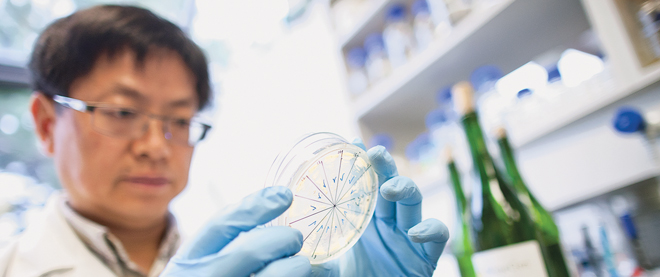Headache-free wine?
A Vancouver microbiologist wants to make the world a better place for oenophiles
Photo by Simon Hayter
Share

Enlightened self-interest is a powerful motivator. For 15 years now, Hennie van Vuuren has been building an army—one yeast cell at a time—to make the world a better, safer place for fellow wine lovers, a world without headaches and other nasty things. Van Vuuren, a South African-born microbiologist, holds the Eagles Chair in Food Biotechnology at the University of British Columbia, and he is the founding director of its Wine Research Centre, a little slice of heaven for oenophiles, and home to some 30 graduate student researchers and faculty.
The heart of the centre, at least for the less scientifically inclined, is the Wine Library, a temperature-controlled vault cradling a growing collection of some 6,000 bottles, many from B.C.’s burgeoning Okanagan vineyards. But there’s also a sampling of some of the best vintages from around the globe—donated by patrons in exchange for a tax receipt. You can’t make great wine unless you have tasted greatness, he says, and few students can afford that luxury. “We use these wines to train our graduate students.”
But while van Vuuren is passionate about the finished product, the focus of his academic research in South Africa, at Ontario’s Brock University, and now 12 years at UBC, is the lowly yeast cell, one of wine’s essential building blocks. Through years of research and genetic manipulation, his team has created a yeast that stops the production of headache-inducing allergens in wine, others that drastically reduce the presence of a carcinogen, and he’s closing in on another to reduce alcohol levels while enhancing flavour and body.
In one of life’s cruel ironies, van Vuuren the wine lover is among the 30 per cent of the population who suffer headaches, the result of an allergic reaction to the bioamines like histamine in many younger reds and some whites. “Ah, the headaches,” he says. “It’s a big problem.” He’s invested seven years of research and eight years of testing to create a genetically modified yeast that simplifies wine production and eliminates the allergen. At present, most reds and chardonnay whites undergo a secondary fermentation during which a bacteria is added to stabilize the wine and reduce its harsh acidity. An unfortunate by-product is the bioamines van Vuurren can’t tolerate. Until now, sufferers settled for certain whites or splurged on well-aged reds where the allergens have degraded. “That’s why I drink old wines, but it’s so expensive,” he says. “Still, I love my wine and I endure a headache now and then for a good bottle.”
His new malolactic yeast—ML01—converts tart malic acid to softer lactic acid without need of secondary fermentation or the creation of allergens. Technically, the new yeast is a GMO—genetically modified organism—though it doesn’t introduce material not otherwise present in fermentation. It is approved by Canadian and U.S. regulators. Winemakers, a conservative lot, are overcoming initial qualms now that it is becoming commercially available, van Vuuren says.
Meantime, within a relatively short four-year span, van Vuuren’s group has developed a group of yeasts that almost eliminate ethyl carbamate, a suspected carcinogen found in trace levels of wine, in distilled alcoholic beverages, and even bread. It is produced when urea, secreted by yeast, reacts with alcohol created during fermentation. His improved yeast degrades urea, preventing formation of the toxin. “Last year 80 wineries in the United States tried the yeast. It worked perfectly,” he says. “They were unable to distinguish wine made with this yeast compared to wine produced with the original yeast strain, which was not modified.” He hopes to apply the breakthrough to bread yeast as well.
Van Vuuren is also at work on a yeast to reduce the stratospheric levels of alcohol in wines from regions like California, where grapes hang longer on the vine, reducing bitter tannins but increasing the sugar that yeast turns to alcohol. “One of the best wines I ever had in my life was a ’61 Lafite,” he says. “It had 10.5 per cent alcohol, you can taste the wine.” Vintages in the 16-per-cent range tend to burn the mouth, quite apart from putting you over the legal limit after just a glass or two, he says.
He launches into a discussion of the “metabolic pathways” of yeast, and ways it can be encouraged to produce more flavour and body and less alcohol. “Yeast is such a fantastic little organism, a beautiful little organism,” he says. Listening to him speak, one wishes such enthusiasm could be bottled. But, come to think of it, that is the point of the exercise.